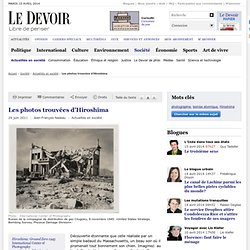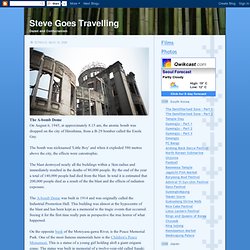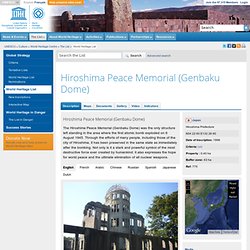

Les photos trouvées d'Hiroshima. Découverte étonnante que celle réalisée par un simple badaud du Massachusetts, un beau soir où il promenait tout bonnement son chien.

Imaginez: au bord d'un trottoir, une valise remplie de vieilles photographies. Il la ramasse et y découvre des images prises à Hiroshima après l'explosion de la bombe qui, le 6 août 1945, rasa la ville en une fraction de seconde sous l'effet d'une boule de feu atomique. Ces photos exceptionnelles, découvertes par ce passant curieux, sont exposées jusqu'au 28 août à New York, à l'International Center of Photography.
L'exposition présente une soixantaine de tirages qui montrent des poutres d'acier tordues comme des cure-pipes et des édifices pulvérisés comme des châteaux de cartes. Les images sont frontales, très dures, sans mise en scène. Ces photos saisissantes ont été trouvées par Don Levy, qui a ramené ce petit trésor à la maison et en a parlé autour de lui. Ces documents appartenaient à l'origine à un ingénieur américain du nom de Robert L. Hiroshima & nagasaki. The Atomic Bomb and the End of World War II: A Collection of Pri. Washington, D.C., August 5, 2005 - Sixty years ago this month, the United States dropped atomic bombs on Hiroshima and Nagasaki, the Soviet Union declared war on Japan, and the Japanese government surrendered to the United States and its allies.

The nuclear age had truly begun with the first military use of atomic weapons. With the material that follows, the National Security Archive publishes the most comprehensive on-line collection to date of declassified U.S. government documents on the atomic bomb and the end of the war in the Pacific. Besides material from the files of the Manhattan Project, this collection includes formerly "Top Secret Ultra" summaries and translations of Japanese diplomatic cable traffic intercepted under the "Magic" program. Moreover, the collection includes for the first time translations from Japanese sources of high level meetings and discussions in Tokyo, including the conferences when Emperor Hirohito authorized the final decision to surrender.[1] I.
A. Steve Goes Travelling. The A-bomb DomeOn August 6, 1945, at approximately 8.15 am, the atomic bomb was dropped on the city of Hiroshima, from a B-29 bomber called the Enola Gay.

The bomb was nicknamed 'Little Boy' and when it exploded 580 metres above the city, the effects were catostrophic. The blast destroyed nearly all the buildings within a 3km radius and immediately resulted in the deaths of 80,000 people. By the end of the year a total of 140,000 people had died from the blast. Hiroshima Peace Memorial (Genbaku Dome) - UNESCO World Heritage. Hiroshima Peace Memorial (Genbaku Dome) The Hiroshima Peace Memorial (Genbaku Dome) was the only structure left standing in the area where the first atomic bomb exploded on 6 August 1945.

Through the efforts of many people, including those of the city of Hiroshima, it has been preserved in the same state as immediately after the bombing. Not only is it a stark and powerful symbol of the most destructive force ever created by humankind; it also expresses the hope for world peace and the ultimate elimination of all nuclear weapons. Mémorial de la paix d'Hiroshima (Dôme de Genbaku) Le Mémorial de la Paix d'Hiroshima, ou Dôme de Genbaku, fut le seul bâtiment à rester debout près du lieu où explosa la première bombe atomique, le 6 août 1945. النصب التذكاري للسلام في هيروشيما (قبّة جينباكو) يُعتبَر النصب التذكاري للسلام في هيروشيما، أو قبة جينباكو، المبنى الوحيد المتبقّي قرب المكان حيث انفجرت القنبلة النوويّة الأولى في 6 آب أغسطس 1945.
Source: UNESCO/ERI 广岛和平纪念公园(原爆遗址) Le site original. The Official Homepage of Hiroshima Peace Memorial Museum.